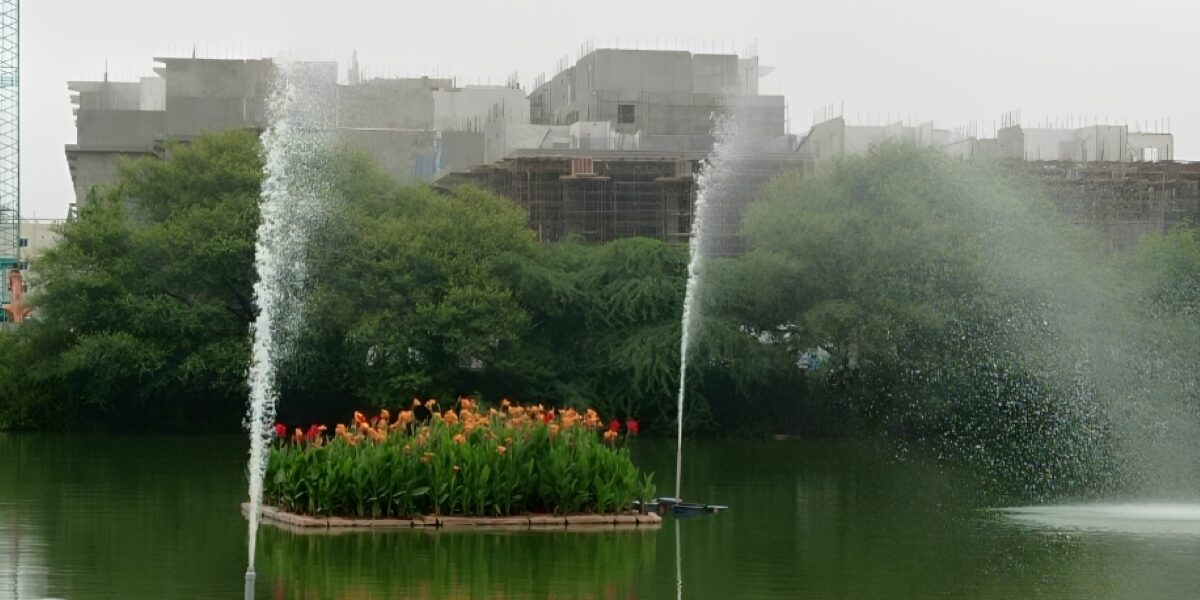The Compendium of Best Practices for Water Management 3.0 noted that the Neknampur lake was now “beautiful", with "no smell or odour”.

Water cycles are being used to keep the Neknampur lake clean. (Supplied)
The NITI Aayog has included the Neknampur lake in Hyderabad as an example in its latest compendium of best practices for water management.
The report recognised the work carried out at the lake that resulted in its restoration. Thus, the lake was included in the “Watershed Development” category of the report, along with a few others.
The other categories are Policy-led Interventions, Smart Water Infrastructure, Wastewater Treatment and Reuse, and Climate-Resistant Water Management.
The NITI Aayog, in its Compendium of Best Practices for Water Management 3.0, noted that the Neknampur water body was now a “beautiful lake with no smell or odour”, but also that sewage was still coming into it.
It added that water hyacinth plants were still in the lake, but never covered it, as they would do even a few years ago.
It also said that the lake was now a recreational place for the community.
The NITI Aayog highlighted that the restoration of the Neknampur lake was an achievement of the Hyderabad-based NGO Dhruvansh, which took the initiative in 2016 to save the lake that was filled with garbage.
Dhruvansh CEO Madhulika Choudhary told South First, “We managed to become an example for the whole country with a small team and only a few volunteers.”
She recalled: “The lake was filled with water hyacinth and garbage. Even local residents had no idea that there was a water body nearby.”
“We planted saplings along the lake shore under the Haritha Haram programme, which started my lake journey in July 2016. The state government removed the legacy garbage dumping yard at the lake and created a nimarjanam pond (a pond for the ceremonial immersion of idols) which proved to be a blessing for the water body,” Choudhary said.
She added: “It was then that the community came to know that there was a lake there, and it is now acquiring cultural importance rather than domestic garbage.”
The Hyderabad Metropolitan Development Authority (HMDA) extended its support when the government permitted the NGO to work on the lake, sanctioning funds in 2018 for a floating island in the lake.
Since the lake was filled with water hyacinth, the NGO came up with the idea of using floating treatment wetlands to counter the species.
Floating treatment wetlands are platforms where phytoremediation plants — plants that reduce the content, or toxic effects, of contaminants — are grown without soil.
The lake currently uses tools like floating bikes to pick up garbage that is thrown into the water.
Many biodiversity species are currently found in and around the lake. These include rock pythons, monitor lizards, mongooses, mainly flapshell and pond terrapin turtles, and emperor dragonflies.
The lake is also home to 170 varieties of birds — including the Eurasian wryneck — and five varieties of fish.
Ibrahim Quli Qutub Shah is said to have founded the Neknampur lake when the Hussain Sagar and the Ibrahimpatnam lake were created. This was somewhere in the middle of the 16th century CE.
The lake’s name is Ibrahim Bagh Cheruvu according to the government’s records.
However, Choudhary said she started calling it the Neknampur lake as she was unable to pronounce the word cheruvu (the Telugu word for “lake”). She also noted that it was between the Neknampur village and Ibrahim Bagh.
Meanwhile, the NITI Aayog listed eight projects — Jal Samvardhan Yojana in Karnataka, Neeru-Chettu Programme in Andhra Pradesh, Sujalam Sufalam Jal Abhiyan in Gujarat, Mukhyamantri Jal Swavlamban Abhiyan in Rajasthan, Drink From Tap Mission (24×7 Water Supply) in Odhisa, Kapildhara Yojana in Madhya Pradesh, and Jalyukt Shivar Abhiyan in Maharashtra — under notable “policy-led interventions” in its compendium
Besides Neknampur, the other projects listed under the “watershed development” head are reversing salinity in Saurashtra, rejuvenation of the Khadakwasla Dam for augmentation of water use, diversion-based irrigation systems, and clean and safe drinking water in Odisha.
Under smart water infrastructure, there were growing tomatoes without soil using vertical farming in hydroponics, waterless dyeing technology in textile processing, reuse of treated water in Arequipa in Peru, the Namakkal district of Tamil Nadu becoming water-secure, the reuse of treated water in a thermal power plant in Nagpur, and watershed development in Hyderabad to address water scarcity.
Under climate-resilient water management, the compendium listed temporary floodwater storage in agricultural areas in the Middle Tisza river basin in central Europe, the Sihlanzimvelo stream cleaning project in Africa, the Metropolitan Area Outer Underground Discharge Channel or MAOUDC in Japan, and the flood-forecasting and early-warning system in Kolkata.

May 18, 2024

May 18, 2024

May 17, 2024

May 17, 2024

May 17, 2024

May 16, 2024